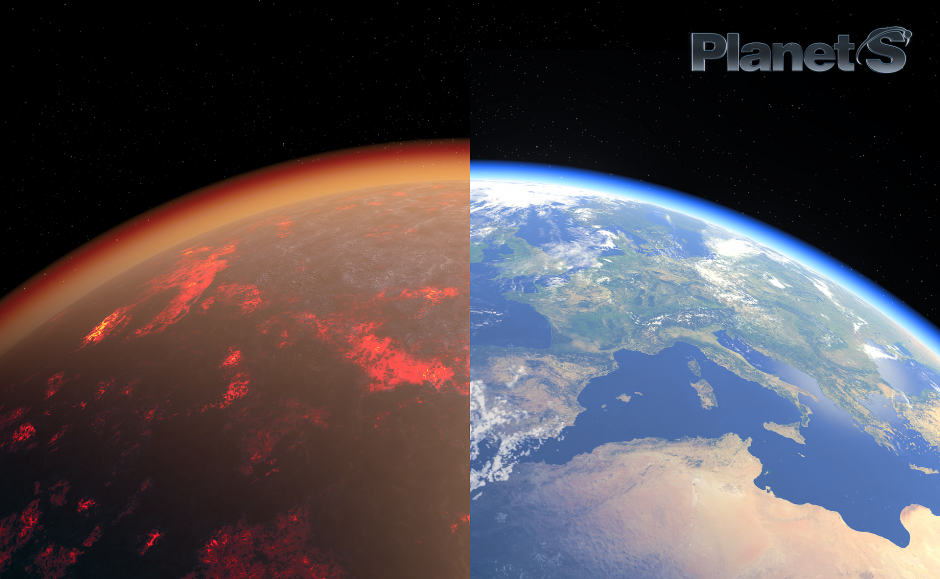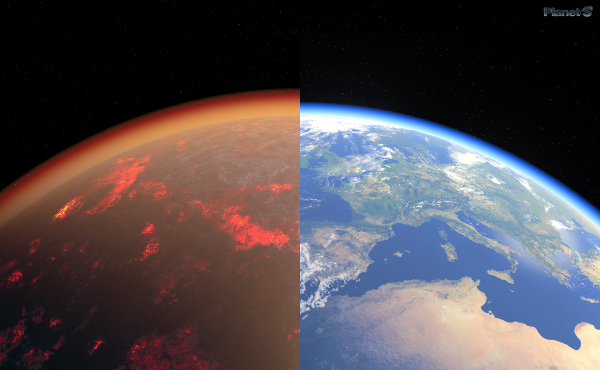New insights into Earth’s primeval atmosphere

A team of international scientists, led by the ETH Zurich and the National Centre of Competence in Research (NCCR) PlanetS, has gained new insights into Earth’s atmosphere of 4.5 billion years ago. Their results have implications for the possible origins of life on Earth.

An artistic illustration of Earth today and 4.5 billion years ago. Image credit: Tobias Stierli
Four and a half billion years ago, Earth would have been hard to recognize. Instead of the forests, mountains and oceans that we know today, the surface of our planet was covered entirely by magma – the molten rocky material that surfaces when volcanoes erupt. This much the scientific community agrees on. What is less clear, is what the atmosphere at the time was like. New international research efforts, led by Paolo Sossi, senior research fellow at ETH Zurich and the NCCR PlanetS, attempts to lift some of the mysteries of Earth’s primeval atmosphere. The findings were published today in the journal Science Advances.
Making magma in the laboratory
“4.5 Billion years ago, the magma constantly exchanged gases with the overlying atmosphere”, Paolo Sossi begins to explain; “the air and the magma influenced each other. So, you can learn about one from the other”.
To learn about Earth’s primeval atmosphere, which was very different from what it is today, the researchers therefore created their own magma in the laboratory. They did so by mixing a powder that matched the composition of Earth’s molten mantle and heating it. What sounds straightforward required the latest technological advances, as Sossi points out: “The composition of our mantle-like powder made it difficult to melt – we needed very high temperatures of around 2000 °C”.

The laser-heated aerodynamic levitation furnace, with which Sossi et al. did their experiments. Image credit: IPGP.
That required a special furnace, that was heated by a laser and within which the researchers could levitate the magma by letting streams of gas-mixtures flow around it. These gas-mixtures were plausible candidates for the primeval atmosphere that, as 4.5 billion years ago, influenced the magma. Thus, with each mixture of gases that flowed around the sample, the magma turned out a little different.
“The key difference we looked for, was how oxidized the iron within the magma became”, Sossi explains. In less accurate words: how rusty. When iron meets oxygen, it oxidizes and turns into what we commonly refer to as rust. Thus, when the gas-mixture the scientists blew over their magma contained a lot of oxygen, the iron within the magma became more oxidized.
This level of iron-oxidation in the cooled-down magma gave Sossi and his colleagues something that they could compare to naturally occurring rocks that make up Earth’s mantle today – so-called peridotites. The iron oxidation in these rocks still has the influence of the primeval atmosphere imprinted within it. Comparing the natural peridotites and the ones from the lab therefore gave the scientists clues about which of their gas-mixtures came closest to Earth’s primeval atmosphere.
A new view of the emergence of life
“What we found was that, after cooling down from the magma state, the young Earth had an atmosphere that was slightly oxidizing, with carbon dioxide as its main constituent, as well as nitrogen and some water”, Sossi reports. The surface pressure was also much higher, almost a hundred times that of today and the atmosphere was much higher, due to the hot surface. These characteristics made it more similar to the atmosphere of today’s Venus than to that of today’s Earth.

Dr. Paolo Sossi is an SNF Ambizione Fellow at the ETH Zurich.
This result has two main conclusions, according to Sossi and his colleagues:
The first is that Earth and Venus started out with quite similar atmospheres but the latter subsequently lost its water due to the closer proximity to the Sun and the associated higher temperatures. Earth, however, kept its water, primarily in the form of oceans. These absorbed much of the CO2 from the air, thereby reducing the CO2-levels significantly.
The second conclusion is that a popular theory on the emergence of life on Earth now seems much less likely. This so-called “Miller-Urey experiment”, in which lightning strikes interact with certain gases (notably ammonia and methane) to create amino-acids – the building blocks of life – would have been difficult to realize. The necessary gases were simply not sufficiently abundant.
“While we could answer some questions on the origins of life on Earth, others – such as how life can develop in CO2-rich atmospheres – remain open”, Sossi concludes, “this much seems clear: much like Icarus learned, flying too close to the Sun makes life difficult”.
Publication details: Redox state of Earth’s magma ocean and its Venus-like early atmosphere, Sossi, P.A., Burnham, A. D., Badro, J., Lanzirotti, A., Newville, M. & O’Neill, H.St.C., Science Advances. doi: 10.1126/sciadv.abd1387
Categories: News
